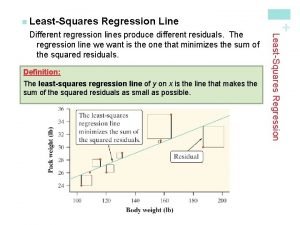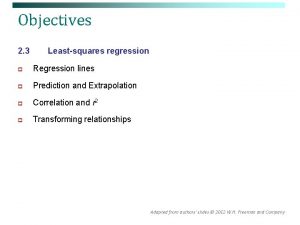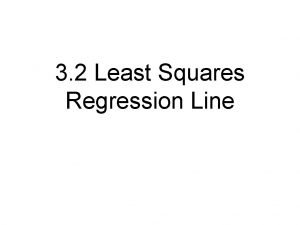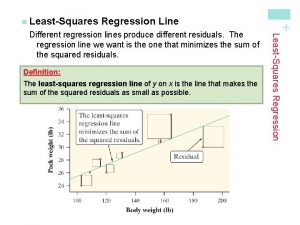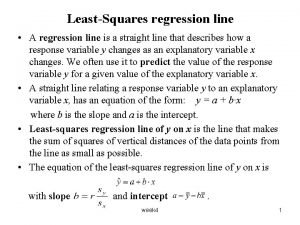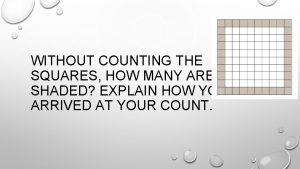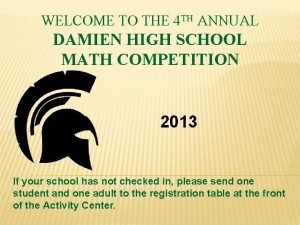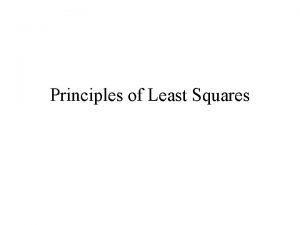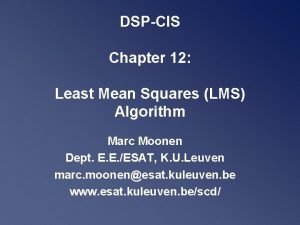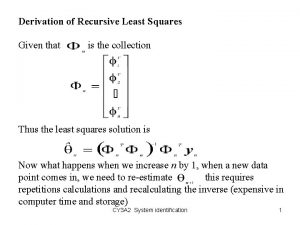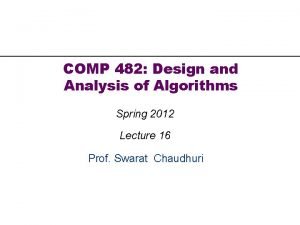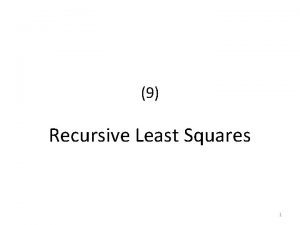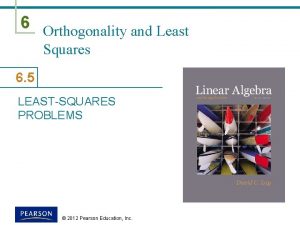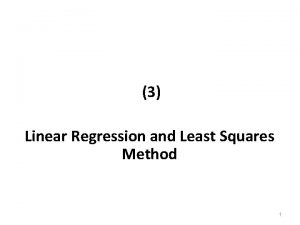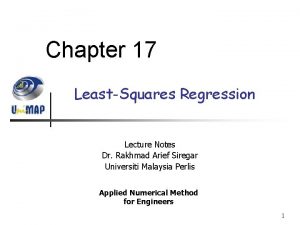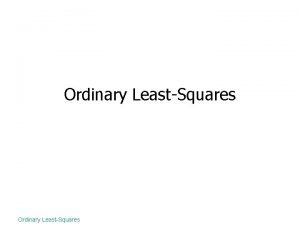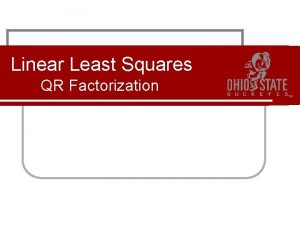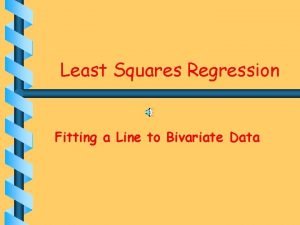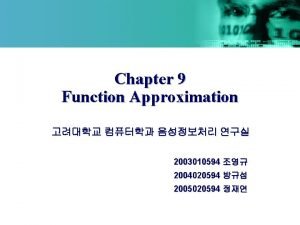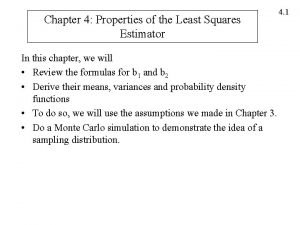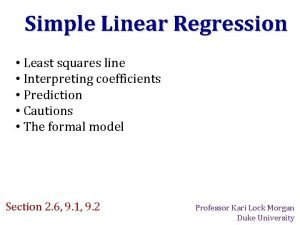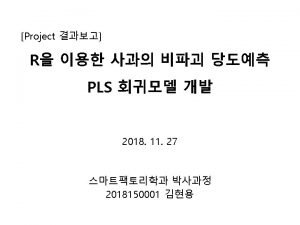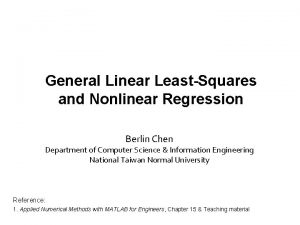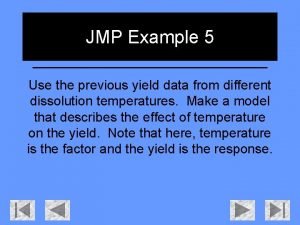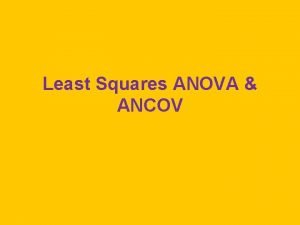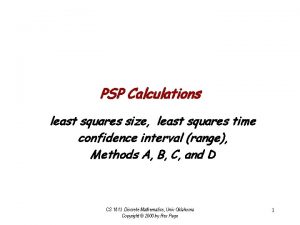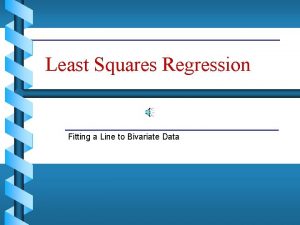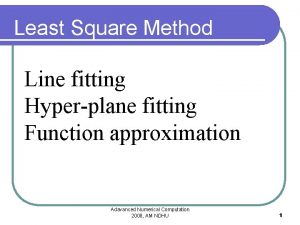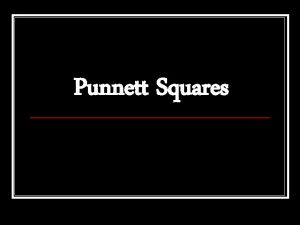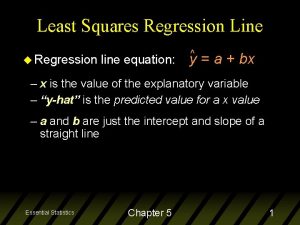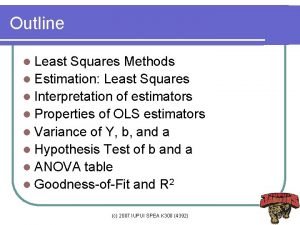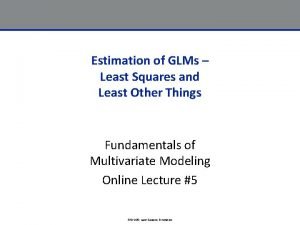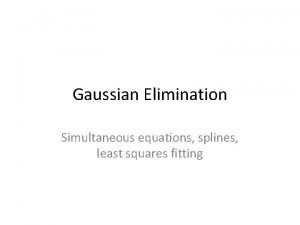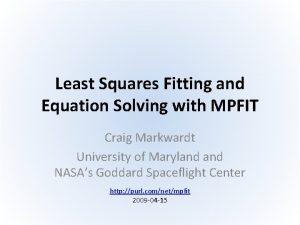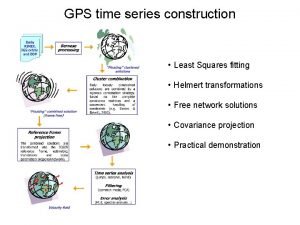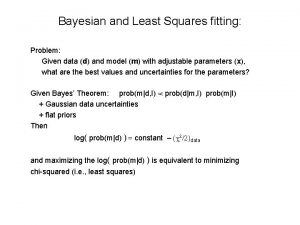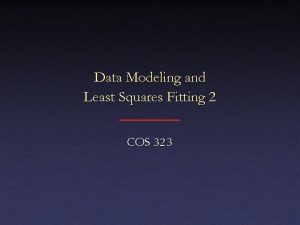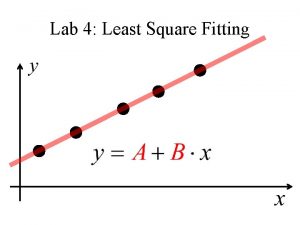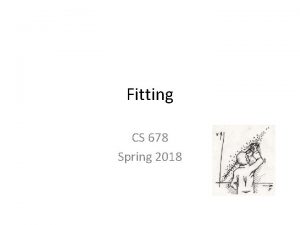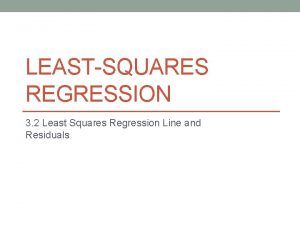Line Fitting James Hayes Least squares line fitting

























- Slides: 25

Line Fitting James Hayes

Least squares line fitting • Data: (x 1, y 1), …, (xn, yn) • Line equation: yi = m xi + b • Find (m, b) to minimize y=mx+b (xi, yi) Matlab: p = A y; Modified from S. Lazebnik

Least squares (global) optimization Good • Clearly specified objective • Optimization is easy Bad • May not be what you want to optimize • Sensitive to outliers – Bad matches, extra points • Doesn’t allow you to get multiple good fits – Detecting multiple objects, lines, etc.

Least squares: Robustness to noise • Least squares fit to the red points:

Least squares: Robustness to noise • Least squares fit with an outlier: Problem: squared error heavily penalizes outliers

Robust least squares (to deal with outliers) General approach: minimize ui (xi, θ) – residual of ith point w. r. t. model parameters θ ρ – robust function with scale parameter σ The robust function ρ • Favors a configuration with small residuals • Constant penalty for large residuals Slide from S. Savarese

Choosing the scale: Just right The effect of the outlier is minimized

Choosing the scale: Too small The error value is almost the same for every point and the fit is very poor

Choosing the scale: Too large Behaves much the same as least squares

Robust estimation: Details • Robust fitting is a nonlinear optimization problem that must be solved iteratively • Least squares solution can be used for initialization • Scale of robust function should be chosen adaptively based on median residual

Other ways to search for parameters (for when no closed form solution exists) • Line search 1. 2. • Grid search 1. 2. • For each parameter, step through values and choose value that gives best fit Repeat (1) until no parameter changes Propose several sets of parameters, evenly sampled in the joint set Choose best (or top few) and sample joint parameters around the current best; repeat Gradient descent 1. 2. Provide initial position (e. g. , random) Locally search for better parameters by following gradient

Hypothesize and test 1. Propose parameters – – – Try all possible Each point votes for all consistent parameters Repeatedly sample enough points to solve for parameters 2. Score the given parameters – Number of consistent points, possibly weighted by distance 3. Choose from among the set of parameters – Global or local maximum of scores 4. Possibly refine parameters using inliers

Hough Transform: Outline 1. Create a grid of parameter values 2. Each point votes for a set of parameters, incrementing those values in grid 3. Find maximum or local maxima in grid

Hough transform P. V. C. Hough, Machine Analysis of Bubble Chamber Pictures, Proc. Int. Conf. High Energy Accelerators and Instrumentation, 1959 Given a set of points, find the curve or line that explains the data points best y m x y=mx+b Hough space b Slide from S. Savarese

Hough transform y m b x y m 3 x Slide from S. Savarese 5 3 3 2 2 3 7 11 10 4 3 2 1 1 0 5 3 2 3 4 1 b

Hough transform P. V. C. Hough, Machine Analysis of Bubble Chamber Pictures, Proc. Int. Conf. High Energy Accelerators and Instrumentation, 1959 Issue : parameter space [m, b] is unbounded… Use a polar representation for the parameter space y x Hough space Slide from S. Savarese

Hough transform - experiments features votes Slide from S. Savarese

Hough transform - experiments Noisy data features votes Need to adjust grid size or smooth Slide from S. Savarese

Hough transform - experiments features votes Issue: spurious peaks due to uniform noise Slide from S. Savarese

1. Image Canny

2. Canny Hough votes

3. Hough votes Edges Find peaks and post-process

Hough transform example http: //ostatic. com/files/images/ss_hough. jpg

Incorporating image gradients • Recall: when we detect an edge point, we also know its gradient direction • But this means that the line is uniquely determined! • Modified Hough transform: • For each edge point (x, y) θ = gradient orientation at (x, y) ρ = x cos θ + y sin θ H(θ, ρ) = H(θ, ρ) + 1 end

Finding lines using Hough transform • Using m, b parameterization • Using r, theta parameterization – Using oriented gradients • Practical considerations – Bin size – Smoothing – Finding multiple lines – Finding line segments
 Least squares regression line definition
Least squares regression line definition Least squares regression line statcrunch
Least squares regression line statcrunch How to find lsrl
How to find lsrl Least squares regression line
Least squares regression line Least squares regression line definition
Least squares regression line definition Least squares regression line minitab
Least squares regression line minitab How many squares
How many squares Damien thiesson
Damien thiesson Least square solution
Least square solution Lms cis
Lms cis Recursive least squares python
Recursive least squares python Constrained least squares filtering
Constrained least squares filtering 4d3d41669541f1bf19acde21e19e43d23ebbd23b
4d3d41669541f1bf19acde21e19e43d23ebbd23b Least squares example
Least squares example Least squares problem
Least squares problem The least squares method
The least squares method Polynomial regression least squares
Polynomial regression least squares Geometry of least squares
Geometry of least squares Qr factorization least squares
Qr factorization least squares Bivariate least squares regression
Bivariate least squares regression Continuous least squares approximation
Continuous least squares approximation Least square property
Least square property Least squares regression
Least squares regression Ordinary least squares
Ordinary least squares Least squares matrix
Least squares matrix Fit least squares jmp
Fit least squares jmp
